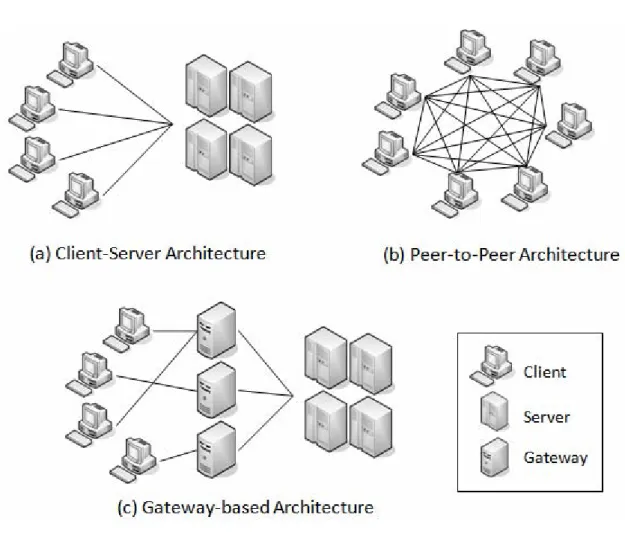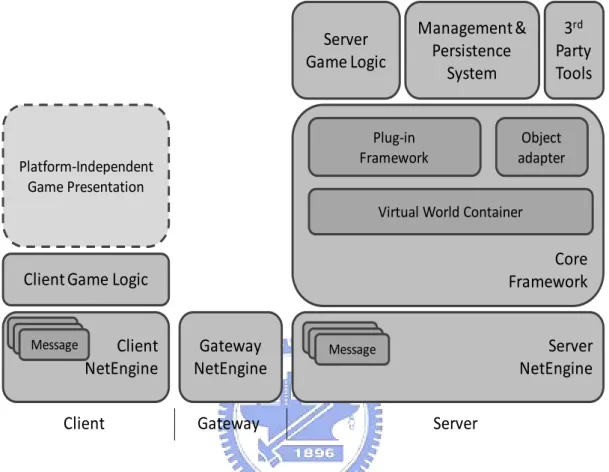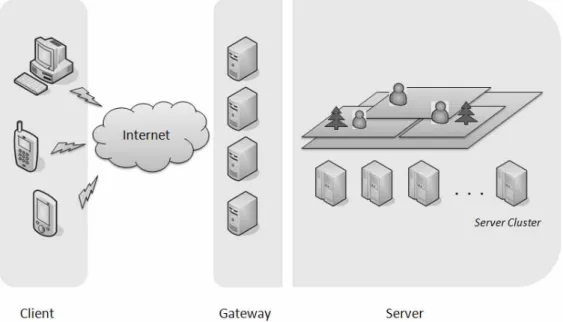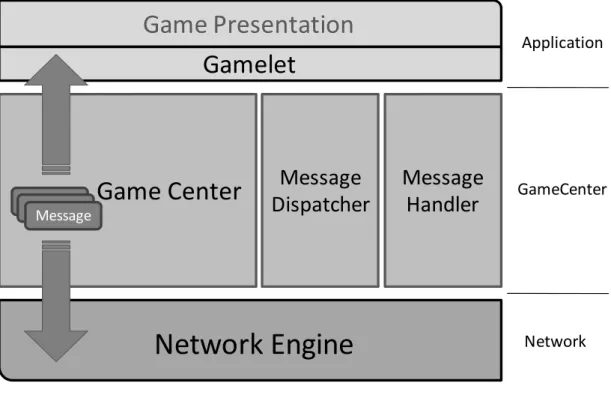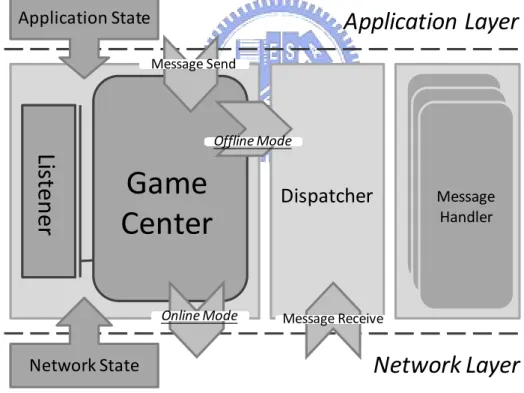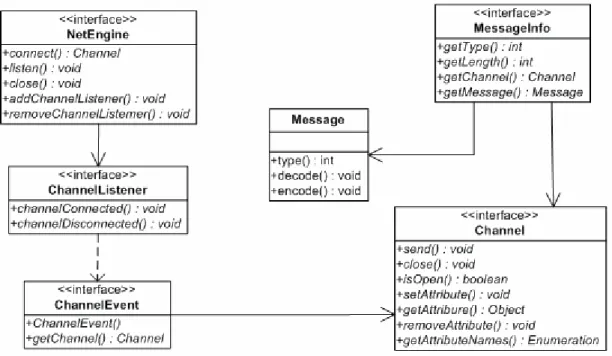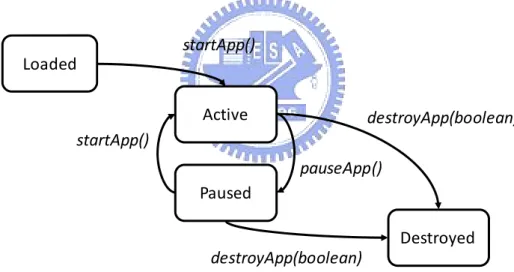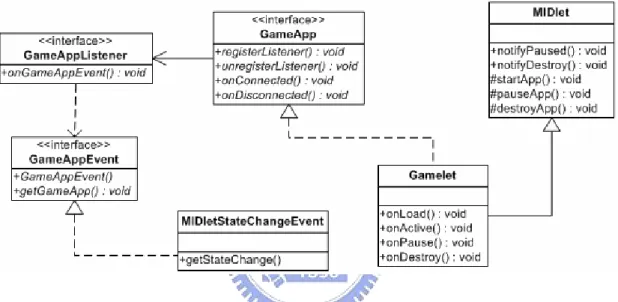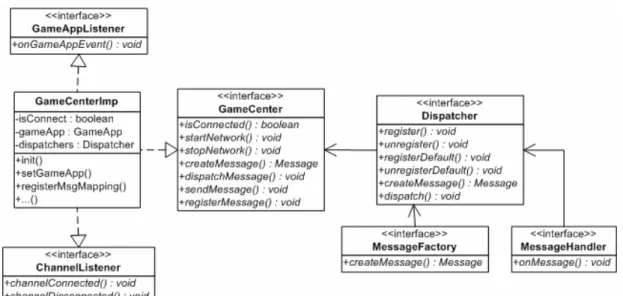國
立
交
通
大
學
資訊科學與工程研究所
碩
士
論
文
一個可支援手持裝置之巨量多人連線遊戲
的
客
戶
端
框
架
A Client Framework for Massively Multiplayer Online
Games on Mobile Devices
研 究 生:彭品勻
指導教授:袁賢銘 教授
一個可支援手持裝置之巨量多人連線遊戲的客戶端框架
A Client Framework for Massively Multiplayer Online Games
on Mobile Devices
研 究 生:彭品勻 Student:Pin-Yun Peng
指導教授:袁賢銘 Advisor:Shyan-Ming Yuan
國 立 交 通 大 學
資 訊 科 學 與 工 程 研 究 所
碩 士 論 文
A ThesisSubmitted to Institute of Computer Science and Engineering College of Computer Science
National Chiao Tung University in partial Fulfillment of the Requirements
for the Degree of Master
in
Computer Science
July 2007
Hsinchu, Taiwan, Republic of China
一個可支援手持裝置之巨量多人連線遊戲
的客戶端框架
研究生:彭品勻 指導教授:袁賢銘 國立交通大學資訊科學與工程研究所
摘要
Massively Multiplayer Online Game (MMOG) 是目前非常受歡迎的一種遊戲
類型,其特色在於可支援上千人同時在一個持續性的遊戲世界中進行遊戲。而隨 著手持裝置遊戲市場的成長,以及無線技術的進步,手持裝置上的 MMOG 不但 可行也開始受到重視。開發一款巨量多人連線遊戲有非常多的議題需要考量,尤 其手持裝置遊戲必須在數百種裝置上運作,使得佈署與散佈 MMOG 更加困難。 此外,手持裝置的應用程式容易受到周遭環境,像是電信服務或是網路連線問題 的干擾。這些都使得開發手持裝置多人連線遊戲倍受挑戰。在本篇論文中,我們 將提出一個考量 MMOG 與手持裝置遊戲議題的 MMOG 客戶端框架。嘗試提供 一個具有彈性且容易佈署的平台,並使傳統 MMOG 與手持裝置 MMOG 的結合 成為可能。
A Client Framework for Massively Multiplayer Online Games
on Mobile Devices
Student:Pin-Yin Peng Advisor:Shyan-Ming Yuan
Department of Computer Science
National Chiao Tung University
Abstract
Massively Multiplayer Online Game (MMOG) is the recently popular game
genre that is capable of supporting more than thousands of players in a persistence
game world concurrently. With the growing of mobile game market size and
improvement of wireless technology, a MMOG on mobile device is possible and
being concerned. There are many issues that may be encountered when developing a
MMOG. Since the mobile game must be created to run on hundreds of device, to
deploy and distribute the MMOG on mobile device is harder. Also, the mobile
application is easily interrupted by the surrounding environment, such as telecom
service or network connectivity. Those make the mobile online game development
more challenging. In this paper, we will propose a client framework for MMOG on
mobile device that consider both MMOG and mobile games issues. We will try to
provide a flexible and easy-to-deploy platform and also make the combination of
Acknowledgement
首先要誠摯地感謝指導教授袁賢銘博士,從大四專題開始,以自由開明的風 氣帶領我們,並給予最大的研究創意空間,使我在這些年中獲益匪淺。其次要感 謝所有口試委員,在百忙之中給予我許多寶貴的建議,使得本篇論文能夠更完整 而嚴謹。 在交大分散式系統實驗室裡,不管是學術上的討論,或是生活點滴的關心, 感謝所有的學長姐、同學、學弟妹,因為你們讓兩年的研究生活變得多彩多姿。 特別感謝蕭存喻、葉秉哲、吳瑞祥、鄭明俊、邱繼弘學長們,在研究過程中給予 許多指導與建議,並感謝曾共同參與相關研究的陸振恩、蘇科旭、葉倫武、范志 欽學長們。此外,也感謝宋牧奇、脫志曜、熊家媛、蔡宗穎、尤喜夫同學,在這 同窗兩年的期間,互相激勵與幫助。 最後,感謝父母從小的養育與教誨,給予我良好的學習環境,讓我的求學生 活無後顧之憂,並以此文獻給我摯愛的雙親。Table of Contents
Acknowledgement...III
Table of Contents ... IV
List of Figures...VII
List of Tables... VIII
Chapter 1 Introduction...1
1.1 Preface...1
1.2 Motivation...1
1.3 Research Objectives...2
1.4 Outline of the thesis ...4
Chapter 2 Background ...5
2.1 Communication model of online games ...5
2.1.1 Client-Server Architecture ...6
2.1.2 Peer-to-Peer Architecture...6
2.1.3 Gateway-based Architecture ...6
2.2 Technology Platform of Mobile Devices ...7
2.2.1 Java ...7
2.2.2 BREW ...7
2.2.4 Windows Mobile...8
2.3 DOIT middleware platform ...9
2.4 Existing Online Game Platforms on Mobile Devices...10
2.4.1 BigWorld Technology ...10
2.4.2 Ex Machina – Julius solution... 11
2.4.3 GASP ... 11
2.5 Summary ...12
Chapter 3 System Architecture...13
3.1 Three-Tier Architecture Overview ...13
3.2 Mobile Online Game Client Architecture ...14
3.2.1 Network Layer ...15
3.2.2 GameCenter Layer ...16
3.2.3 Application Layer...17
3.3 Game Protocol Development ...17
Chapter 4 Implementation Details ...19
4.1 Network Component...19
4.2 Game Application Layer ...21
4.2.1 MIDlet...21
4.3 GameCenter Layer ...23
4.4 Message Class and Config File Generator...24
4.5 Development Flow...27
Chapter 5 Application Demonstration...29
5.1 Mobile RPG engine...29
5.2 Game rule and protocol...30
5.3 Combine with PC version ...31
5.4 Offline Game Playing ...31
5.5 Implementation and result screenshot...32
Chapter 6 Conclusions and Future Works ...36
6.1 Conclusions...36
6.2 Future Works...37
Chapter 7 Reference ...39
Appendix...42
A.1 XML Schema Definition of Message Protocol...42
A.2 Development Example...43
A.2.1. Game Application ...43
A.2.2. Game Center ...44
List of Figures
Figure 2-1 Communication model of online service ...5
Figure 2-2 DOIT platform architecture and component ...9
Figure 3-1 Client-Gateway-Server Architecture...13
Figure 3-2 Mobile Online Game Client Architecture ...15
Figure 3-3 Detail layout and processing of GameCenter Layer ...16
Figure 4-1 Message format and process ...19
Figure 4-2 Class diagram of network component...20
Figure 4-3 Life cycle of a MIDlet...21
Figure 4-4 Game application interface and Gamelet class ...22
Figure 4-5 Class diagram of the GameCenter layer...23
Figure 4-6 Development flow...27
Figure 5-1 Screenshot of the mobieRPG demo game...29
Figure 5-2 Login form and game world...33
Figure 5-3 Player in the paused state ...33
List of Tables
Table 4-1 The definition of message and related components...24
Table 5-1 Game protocol of the demo game...30
Chapter 1 Introduction
1.1 Preface
Massively Multiplayer Online Game (MMOG) is the recently popular game
genre that is capable of supporting more than thousands of players in a persistence
game world concurrently. With the growing of mobile game market size and
improvement of wireless technology, a MMOG on mobile device is possible and
being concerned. There are many issues that may be encountered when developing a
MMOG. Since the mobile game must be created to run on hundreds of device, to
deploy and distribute MMOG on mobile device makes the game development more
challenged. Therefore, a middleware solution for MMOG on mobile device gains
more and more respect.
1.2 Motivation
With the capability growth of mobile device and the innovation of the wireless
communication technique, wireless entertainment is respected recently. By the
investigation in IGDA (International Game Developers Association) [1] , 2005 Mobile
Game White Paper [2] , the recent market trend shows that: the availability and
quality of games are enhanced, network capability is improved and more traditional
game publishers jump in. The game-play habits of consumers also change and reveal
that they play for more than just killing down time.
Furthermore, the evolution of wireless technique leads the high speed, high
will support new distribution models and realize new game play types. It provides not
only the online game service but enable the true real-time games between handsets
and even as part of existing large network with PC and consoles.
All of the above inspires the design of mobile online games and game
development platforms. Even though there are many existing MMOG and mobile
game middleware solutions, most of them are closed and commercial products and
focus only on MMO (Massively Multiple Online) or Mobile topic. As a MMO
platform, it confronts more challenges in server-side management and system
architecture, such as scalability, flexibility, load-balancing and performance. When the
game world grows up, the system should support the increasing players and contents
and then provide a load-balancing and high-performance service. Furthermore, the
whole system should offer a flexible game protocol and content design to satisfy
many different game types.
On the other hand, to design a mobile game platform, there are usually more
client-side handset issues to be considered. The mobile client application is easy to be
interrupted by surrounding environment. For example, when user is out of service
range or receiving a coming call, the client application may suspend and even lose
application resource. Therefore, we propose a client framework for MMOG on mobile
device that consider both MMOG and mobile games issues. We hope to provide a
flexible and easy-to-deploy platform and also make the combination of traditional
MMOG and mobile MMOG possible.
1.3 Research Objectives
y Easy to Adapt and Extend
The game contents and types of a MMOG can be various. An inflexible MMOG
middleware will restrain the originality of game design. The communication protocol
of middleware online service must be straightforward and easy to adapt and extend.
The Game objects that present in the game world should also be as flexible as
possible. We can provide some typical game object models but should not assume the
forms of them. An ideal game middleware must provide the maximum resilience for
game design.
y Easy to Develop and Deploy
Time to market is very important for the game provider. The development of
game contents need to be easy and fast. The platform should provide simple and
flexible API for game developer. Moreover, most MMOG vendors update the contents
frequently to provide attractive game. The game deployment mechanism should be
simple to reduce the cost of content extension.
y Dealing with the Mobile-specific issue
The situation of a mobile game client is more complex than typical PC or
console games. Although the quality and speed of wireless communication has been
improved, the surrounding environment and many telecom issues will still make the
network connectivity being poor. The application state on mobile handset is also hard
to control. The limited hardware resource and high-priority telecom service will let
the client application be interrupted easily. Thus, the framework of MMO mobile
game client should take above problems into account and provide easy-to-use
y Combination of mobile and traditional MMOG
The spirit and game-play on PC MMOG and mobile MMOG can be the same.
Although the PC or console provides more resource and capability to present such
kind of game, the innovation of mobile device makes the combination possible. Even
if the presentation may be different, by using the same communication protocol, the
mobile device should be able to function the same game logic and play in the same
virtual game world.
1.4 Outline of the thesis
In Chapter 2, we discuss the background of MMOG and mobile application
development and introduce some existing platforms. In Chapter 3, we propose the
architecture of our system, and discuss the purpose and responsibility of each
component. For deep understanding, we describe the implementation details and the
design method in Chapter 4. To demonstrate the usefulness of the platform we
propose, the contents of Chapter 5 presents a hybrid MMO game built on our system.
Chapter 2 Background
2.1 Communication model of online games
To design an online service, communication model is an important part. Here is
the discussion of three common types, namely, Client-Server, Peer-to-Peer and
Gateway-based architecture. For MMOG platform, we may focus on the scalability to
support massively clients. Moreover, since the client platform may be varied, the
capability and related issue of client must be considered.
2.1.1 Client-Server Architecture
Client-Server model is the traditional architecture for online service and can also
be applied to MMOG platform. Large-scale MMO Games, such as Ultima Online [3] ,
Lineage [4] or World of Warcraft [5] , often use server cluster (see Figure 2-1(a)) to
handle massive players and provide a centralized and reliable service. But when the
virtual game world extends or players increase, it may suffer from the scalability issue
and bandwidth limitation at the server entrance.
2.1.2 Peer-to-Peer Architecture
P2P technique has grown and evolved maturely in recent year. Although P2P
model (shown in Figure 2-1(b)) is suitable for multi-user and content share service,
there are some problems for MMOG. The major one is the consistency problem.
Communication cost for maintaining consistency makes this architecture hard to
extend when user and virtual world grow up. The cheating and management problems
also cause the P2P model uncommon in commercial product. Moreover, for mobile
peer, it is more difficult to build up a large scale multiplayer online game.
2.1.3 Gateway-based Architecture
In the Gateway-based architecture, as Figure 2-1 (c) shows, clients treat
gateways as servers and the gateways dispatch data from clients to the corresponding
backend servers. The benefit of this model is that the gateways share the bandwidth at
server entrance and may reduce the latency from client to server by deploy those
overhand to routing message and make the load-balancing more difficult, it can serve
as a security defender of server and is easy to scale when service loading rises.
2.2 Technology Platform of Mobile Devices
Technology platforms are the hardware system and software component that
form the mobile device application environment. Differing from traditional console or
PC games, a mobile game may need to be implemented in various languages to run on
hundreds of mobile handset. Within this section, we introduce four major platforms
for mobile game client.
2.2.1 Java
Java is a programming language created and maintained by Sun, Inc. The
runtime environment on mobile devices is served by JavaTM Platform, Micro Edition
[6] (Java ME). At present, Java is the most widespread platform technology
apparently in terms of numbers of device shipped. To provide a complete application
environment on mobile phones, a common adopted case is to combine the Connected
Limited Device Configuration [7] (CLDC) with Mobile Information Device Profile [8]
(MIDP).
2.2.2 BREW
Binary Runtime Environment for Wireless [9] , BREW for short, is an
application development platform created by Qualcomm for mobile phones. It
addresses specific market needs while allowing customers to create their own solution
includes hosted management service, network carrier billing system and many game
related features.
2.2.3 Symbian
The Symbian OS [10] is an operating system for mobile devices and is well
known in the form of the Series 60 handsets. There are multiple platforms based upon
Symbian OS that provide the SDK for application development. Applications
developed on it are in general portable between different Symbian handset. For game
development, Symbian OS is great and provides rich graphical feature to perform.
2.2.4 Windows Mobile
Windows Mobile [11] is a compact operating system for mobile devices, such as
Pocket PC, Smart Phone and Portable Media Center, with a set of applications based
on the Microsoft Win32 API. To design the application built on Windows Mobile is a
little similar to the development of desktop Windows application. For the latest
Windows Mobile 6 version, it offers many features with security, scalability and
2.3 DOIT middleware platform
Server NetEngine Gateway NetEngine Client NetEngine Client Game Logic MessageMessageMessage MessageMessageMessage
Core Framework Plug‐in Framework Object adapter Virtual World Container Server Game Logic Management & Persistence System 3rd Party Tools
Client Gateway Server
Platform‐Independent Game Presentation
Figure 2-2 DOIT platform architecture and component
DOIT (Distributed-Organized Information Terra) [12] [13] is a MMOG
middleware platform which has evolved for several years in our lab (DCSLab of CS
NCTU). It presents a client-gateway-server architecture and has following features:
scalability, flexibility, high-performance and ease-to-use API. For game development
customization and enhancement, it provides the user defined message-based protocol
and plug-in framework [14] . The persistence of virtual game world is processes by an
ORM (Object Relational Mapping) database system [15] . Furthermore, it offers a
management tool to monitor the game world [16] .
Up to present, it has been implemented in Java SE solution and got good
whole MMOG middleware platform design and does not provide the detail design of
client framework or any mobile device supporting now.
2.4 Existing Online Game Platforms on Mobile
Devices
Both of MMOG and mobile game market has continued to grow over the past
several years. Although there are some existing MMOG middlewares and mobile
game platforms, most of them are commercial products and developed respectively.
For commercial reasons, it’s hard to figure out the detail design by the public
documents. In this section, we try to explore relevant features as many as possible.
2.4.1 BigWorld Technology
The BigWorld Technology Suite [17] is a complete MMOG solution. It provides
a scalable, reliable, customizable and high performance server infrastructure that can
handle million of players. For managing the development and live support of MMOG,
it offers a management tool to handle cluster setting, view log and check the server
status. The client engine integrates the 3D engine, APIs and a set of tools to build up
and manage a MMOG world. Even the tools for content creation, map editing, and
particle effect generation, the BigWorld Technology suite is covered as well. In
addition, the BigWorld Mobile is a layer for mobile device to integrate with the full
BigWorld online world. You can establish an individual mobile MMOG or build a
2.4.2 Ex Machina – Julius solution
Ex Machina [18] provides a framework to create, deploy and manage multiplayer
online games on mobile, web, broad- and narrowcast. Julius solution combines three
platforms, Deus, IP United and Quiz Engine, to offer an end-to-end solution for
commercial online games. It highlights several features to build up a multiplayer
online game with back-end management system for payment, business model and
in-game advertising. Each of the three platforms has its own duty in Julius. Deus is a
platform and SDK which support massively multiplayer and location based gaming.
IP United is a community gaming service that allows game providers to offer numbers
of online games as part of their own portals and support the cross-game user service
and player competition. Quiz Engine is based on Deus, integrates with IP United, and
can create, edit, and configure multiplayer online quizzes, tests, puzzles and much
more games for any device supported by Deus.
2.4.3 GASP
GASP (GAming Service Platform) [19] [20] is an open source platform, under
L-GPL license, for mobile multiplayer online game. GASP is implemented in pure
Java and conforms the Open Mobile Alliance (OMA) Game Service specification. It
uses the object-oriented communication to communicate between client and server
over cellular phone network using HTTP. GASP server runs as a Apache Tomcat
servlet and uses MySQL database for information storage. Client side interface is
available for J2ME MIDP and Doja profiles. The mobile client sends messages over
HTTP and the message parameters are formed and formatted by the MooDS (Mobile
specify the structure of message using dedicated syntax and generate the message
encoding/decoding classes.
2.5 Summary
By the discussion in sections 2.1, the client-server or gateway-based
communication model is more suitable for MMOG. Especially for commercial
MMPG products, the P2P model may bring out more cheating and business problems.
For technology platforms of mobile devices, although the future of Symbian is worthy
of expectation, the Java technique seems to be essential for widely game deployment
at present. Furthermore, most existing middlewares do not offer to develop a MMOG
that support to run on both PC and mobile device. The platforms that aim at the
Chapter 3 System Architecture
In this chapter, we present the system overview of our framework that includes
the three-tier architecture of the whole online service and the mobile client framework
with several layers. Additionally, in the last subsection, we describe the development
of game protocol in our system.
3.1 Three-Tier Architecture Overview
Base on the analysis of the communication model in section 2.1, we believe that
the gateway-based model is better for multiplayer online game platform, especially
for supporting the mobile device. To realize the objective of integrating with existing
MMOG platform, we choose the DOIT platform as the fundamental three-tier
framework. Since it is not a commercial product and provides abstract interfaces and
flexible message protocol, the integration of different client platforms is feasible.
Figure 3-1 shows the three-tier architecture. In server-side, the server clusters form
the virtual world and handle the game logic and game world persistence. The virtual
game world is divided into multiple regions and each server may contain zero to many
regions. The game objects within one region share the same game context and can
migrate between regions. The gateway in the middle layer is responsible for routing
message from client to server. For mobile online games, the gateway can be designed
to handle special issues related to mobile clients, such as user authentication, session
pending and so on. Moreover, client-side users may use different platforms but the
same protocol to communicate to the server.
3.2 Mobile Online Game Client Architecture
In order to satisfy the various game genres and requirement, an online game
client framework should be flexible, adaptable and easy to customize. In general, the
MMO PC game clients need to connect to server first and keep the connection alive
while a user is playing the game. However, the connectivity of mobile phone clients is
not reliable and some mobile users may wish to spare the network resource indeed.
For example, a white paper [21] of Java BluePrints points out some aspects of
motivation for designing disconnected operation in wireless client and also describes
guidelines to design it. In chief, it mentions two reasons for offline operation, that is,
the poor network quality and typical use cases for mobile wireless devices.
The mobile client application may interrupt by telecom service or surrounding
environment, such as incoming calls, short message or low-battery. The status
changes may cause the resource of the application be released. Therefore, the
management of network connectivity and application status must also be taken into
Game Presentation
Gamelet
Message
Handler
Message
Dispatcher
Game Center
Network Engine
Network GameCenter Application MessageMessage MessageFigure 3-2 Mobile Online Game Client Architecture
To deal with the problems mentioned above, the architecture we design
comprises three layers (Shown in Figure 3-2). Each layer contains several components
and has particular purpose. The data received from server pass through each layer and
is processed as sever update or client-side game logic. In the following subsections,
we discuss the functionality and key point of each layer.
3.2.1 Network Layer
The network layer processes all network connection tasks and communicates
with server. The communication protocol we use is message-oriented that packing any
data transfer between client and server as formatted messages. The network layer
abstracts the implementation as interface and can be implemented with different
network protocols. For example, we can provide HTTP or TCP/UDP implementation
3.2.2 GameCenter Layer
The GameCenter in the middle layer collects information from application and
network layers to analyze the status of game and process game logic. As Figure 3-2
shows, there are three main components: Game Center, Message Dispatcher and
Message Handler. The Game Center receives messages from Application Layer or
Network Layer and passes them to the proper Message Dispatcher according to
current game status. While the dispatcher gets the messages, it dispatches them to
corresponding Message Handler. The handler performs the game logic and then the
game presentation updates at the application layer.
Lis
ten
er
Game
Center
Online Mode Message SendDispatcher
Application Layer
Network Layer
Network Message Handler Network MessageHandlerMessageHandler Offline Mode
Application State
Network State
Message Receive
Figure 3-3 Detail layout and processing of GameCenter Layer
Due to the intermittent network connectivity, the mobile online game may need
to operate in a disconnected mode. Figure 3-3 shows the detailed message processing
listeners monitor the state change of application and network layers. Messages come
from gateway (server) are received and packed by network layer and then dispatched.
On the other hand, the messages create by the game application itself are sent to the
game center layer and forward to the network layer or dispatch to the handler if in
offline mode. Depending on the current situation, the game client can serve in
different mode and support offline play.
3.2.3 Application Layer
The application layer performs the game presentation to player and exchanges
information with lower layers. Since we choose the Java ME solution to develop the
system, the base interface is named “Gamelet” as an extension of MIDlet. The
Gamelet abstracts the implementation of application state change and offers an
event-based interface. The application status can be monitored by defining the
application events and register the listeners. It also provides callback functions to be
notified when network status alters.
3.3 Game Protocol Development
As we use the message-oriented mechanism to communicate between clients and
servers, the development of the game protocol can be simplified as the following
steps:
1. Defining the game logic
2. Transforming the game logic to message protocol
The game logic in Step 1 depends on the game genre or game contents. For
typical role-play games, it may include movement, chat or any interaction between
players and NPCs (Non-Player Character). To deploy those game actions, we need to
transform them into message protocols. The transformation between logic and
protocol is to parameterize the messages. Once the server-side and client-side receive
the messages, they process those messages to perform the game logic and update.
The major workload of the development is to translate message protocol into the
underlying programming language. To simplify the process, we also provide a method
to generate the message class codes and deployment configuration files by defining
the message content and related handler in dedicated syntax. The detail procedure will
Chapter 4 Implementation Details
We describe the detail implementation of our framework in this chapter,
especially on the three-layer client side framework. The syntax of message protocol
definition will also be explained in the final section.
4.1 Network Component
The development of network layer can be separate into three parts, that is,
NetEngine, Channel, and Communication Protocol. NetEngine component is a
message-oriented lightweight service. It supports network establishment method:
connect (for client) or listen (for server). When the connection is established, we can
get the connection handle, Channel, and monitor the state by ChannelListener. The
Channel is an abstraction of connection and executes the data sending/receiving. The
communication protocol we use is a message-based protocol. All data transfered
between client and server are encapsulated as a message and the protocol is defined as
a list of message types.
TYPE LEN CUSTOM 0x01 LEN AVID TYPE LEN CUSTOM
Command Command
Update Update
Client Gateway Server
Header field Customize field Wrap field
Figure 4-1 Message format and process
server. Each message contains the header to specify the message type and length and
the payload of user define data. When a message is received by the gateway, it tags it
with user id (AVID – Avatar ID) to let the game server knows whom the message
belonged to. Then it routes the message to the correct server that holds the player data
now. When the server sends the update message, the gateway unwraps the message as
well.
Figure 4-2 Class diagram of network component
The definition of the network components and their relationship are shown in
Figure 4-2. When the connection is built by the NetEngine, it begins to send and
receive data. We use the Observer design pattern to trace the connection status or any
channel event. One can register a listener that implements the interface
ChannelListener to monitor the Channel. While the data receive from server, it is
identified by the message type and a message template is created. By calling the
decode() function, we retrieve the message contents. Then the MessageInfo with
GameCenter Layer and dispatched to corresponding handler. To send the message is
similar. The message created by the game application is finally encoded by the
encode() function and sent to the gateway.
4.2 Game Application Layer
4.2.1 MIDlet
A MIDlet is a MIDP application in Java ME solution. All applications for MIDP
are able to retrieve properties from the application descriptor and notify and request
state changes. Loaded Active Paused Destroyed startApp() startApp() destroyApp(boolean) destroyApp(boolean) pauseApp()
Figure 4-3 Life cycle of a MIDlet
Figure 4-3 shows the life cycle of a MIDlet and there are four states: loaded, active,
paused, and destroyed. When the MIDlet state changes, the mobile device application
manager will call the related function, staartApp(), pauseApp(), destroyApp(), before
it enters next state. For example, when the mobile phone user has a coming call, the
application manager will call the pauseApp() and force the MIDlet to enter the paused
active state. Depending on the practical implementation, those state transformations
may cause the application resource to be released temporarily. Thus, the game
application itself and the Game Center in the middle layer should be notified when
those state change.
4.2.2 Game application interface
Figure 4-4 Game application interface and Gamelet class
To generalize a game application and the game events of it, we define three
interfaces, GameApp, GameAppListener and GameAppEvent (shown in Figure 4-4).
The GameApp provides abstract functions to be notified and respond when network
connection status changes. We cans specify the application event by implement the
GameAppEvent. To monitor the application events, one can implements the
GameAppListener and registers it.
Therefore, to manage the MIDlet state, we create an abstract Gamelet class that
extends the MIDP MIDlet class and implements the GameApp interface. The Gamelet
wraps the state change procedure calls and provide other abstract functions. When the
executes the notification to report the status modification.
4.3 GameCenter Layer
The main duty of the GameCenter layer is to collect status information and
process the game logic in correct mode. As we discuss in Chapter 3, there are three
main components in the GameCenter layer. The implementation of them is described
afterward.
Figure 4-5 Class diagram of the GameCenter layer
As Figure 4-5 showed, the GameCenter works as the communication medium
between Network and Application layer. Initially, the GameCenter register the
message mapping, including the message type, message factory and message handler,
to the Dispatcher. When a message is received, the network layer calls the
createMessage() function to get the message template that created by the
corresponding MessagFactory. When the message has formatted and packed, the
dispatchMessage() function passes it to the Dispatcher. Then we dispatch the
Furthermore, when the game application create the message and calls the
sendMessage(), the GameCenter forwards it to the network layer and sends to the
server-side. If in disconnected mode, it will be dispatched to the offline handler. By
separating the dispatcher and handlers into different set, we can process the game
logic in multiple modes. By implementing the ChannelListener and GameAppListener
interfaces, the game center can also monitor the network connectivity and application
events.
4.4 Message Class and Config File Generator
To build a message-oriented online game, it needs several messages with
different types that present the game logic are needed. Each message is packed, with
unique type and zero-to-many parameters.
Message Name Name of a message.
Message Type A unique number to identify the message in practice. It
presents as an unsigned integer with range 0~65535.
Message Parameter Customized data of a message. The parameters can be zero
to many with Java primitive type. The order of parameters is
related to the encoding/decoding implementation.
Message Factory Use to create the message. (Factory Design Pattern)
Message Handler Use to process the game logic of a message.
Table 4-1 The definition of message and related components
To define a message protocol, there are several fields and components, as the
(Extensible Markup Language) [22] syntax to define the message format and generate
the corresponding class code and configuration file. The class code includes message
and factory class with proper parameter encoding/decoding operations and
setters/getters functions. The configuration file is used to register the message handler
to the message dispatcher. The XML Document Types Definition is as follows (for
full XML Schema Definition, please refer to Appendix 1A.1):
<?xml version="1.0" encoding="UTF-8"?>
<!ELEMENT MDOIT_Message ( Version, PackageName, Messages )> <!ELEMENT Version (#PCDATA)>
<!ELEMENT PackageName (#PCDATA)> <!ELEMENT Messages ( Message+ )>
<!ELEMENT Message ( MessageName, MessageType, Params, Handlers )> <!ELEMENT MessageName (#PCDATA)>
<!ELEMENT MessageType (#PCDATA)> <!ELEMENT Params ( Param+ )>
<!ELEMENT Param ( ParamName, ParamType )> <!ELEMENT ParamName (#PCDATA)>
<!ELEMENT ParamType (#PCDATA)>
<!ELEMENT Handlers ( OnlineHandler, OfflineHandler )> <!ELEMENT OnlineHandler (#PCDATA)>
<!ELEMENT OfflineHandler (#PCDATA)>
The PackageName specify the Java package of the Message and MessageFactory
classes. Each message includes name, type, parameters and handlers. Since we
support to operate in a disconnected mode, the “Handlers” includes two types of
message handler, one for online mode and one for another. For example, to define a
MoveMessage with playerId and coordination of posX and posY, the content of XML
By parsing this, we generate the Java message class file with corresponding
member fields and functions. Here is the code segment of encoding/decoding
functions.
<?xml version="1.0" encoding="UTF-8"?>
<!DOCTYPE MDOIT_Message SYSTEM "xml/mdoit.dtd"> <MDOIT_Message> <Version>1.0</Version> <PackageName>demo</PackageName> <Messages> <Message> <MessageName>MoveMessage</MessageName> <MessageType>0x01</MessageType> <Params> <Param> <ParamName>playerId</ParamName> <ParamType>int</ParamType> </Param> <Param> <ParamName>posX</ParamName> <ParamType>int</ParamType> </Param> <Param> <ParamName>posY</ParamName> <ParamType>int</ParamType> </Param> </Params> <Handlers> <OnlineHandler>handler.MoveMessageHandler</OnlineHandler> <OfflineHandler>handler.LocalMessageHandler</OfflineHandler> </Handlers> </Message> <!-- Other Messages --> <Message> ... </Message> </MDOIT_Message>
public void decode(MessageBuffer bb) { playerID = bb.getInt();
posX = bb.getInt(); posY = bb.getInt(); }
public void encode(MessageBuffer bb) { bb.putInt(playerID);
bb.putInt(posX); bb.putInt(posY); }
// setters and getters of each member field // ...
With the encode() and decode() function, the NetEngine can pack or unpack the
message by correct order and format. Additionally, we create a configuration file as
follow.
#<type>,<factory>,<handler>,<isOnlineMode>
0x01,demo.MoveMessageFactory,handler.MoveMessageHandler,true 0x01,demo.MoveMessageFactory,handler.LocalMessageHandler,false #other message mapping
...
While the Game Center initialize, it read the configuration file and register the
message mapping. According to this, messages received from network or processed in
offline line mode will be dispatched to correct handler.
4.5 Development Flow
The flow of developing a MMOG on our system is separated into client-side and
server-side (Shown in Figure 4-6). First of all, we define the game protocol for the
game content and create the message definition file. The message and message factory
class codes and configuration file are generated according to the definition. For the
server-side, we also need to define the game objects in the game world. By
implementing both server-side and client-side message handlers, we can perform the
full game logic. Then we write the client-side game application to perform the game
presentation. For mobile version, we may need to handle the application events and
network connectivity. Finally, all of the game protocols are deployed and form a
Chapter 5 Application Demonstration
To demonstrate the MMOG framework we propose, we implement a simple, 2-D
tile-base online RPG game based on an open source mobile RPG engine. We
implement the TCP/IP Network Engine to support the network communication at Java
Me and MIDP application platform. Also, we implement the game center and design
some game rules to show a simple online game with supporting of offline gaming.
(For more implementation detail or development examples, please refer to Appendix
1A.2)
5.1 Mobile RPG engine
Figure 5-1 Screenshot of the mobieRPG demo game
mobileRPG [23] is a 2D Role Playing Game (RPG) engine that targets at Java
ME MIDP platform under GNU General Public License. It provides a set of dedicated
syntax to create the game object, action script and game map for a RPG. Each game
object is defined as an Entity and can set a list of ScriptAction to move automatically.
5-1 Screenshot of the mobieRPG demo gameshows the demo game built on
mobileRPG with players and script Non-Player Characters (NPC) on the Town map.
5.2 Game rule and protocol
There are two kinds of game object in our online game. One is the Player that
represents a user with playerId and 2-D coordination. Game players can move their
character to four directions over the map. The other one is the NPC that moves
randomly and automatically.
Message Name Message Definition and Description
LoginMessage Player login message, include username and password
LoginResultMessage Server sends back the login result
LogoutMessage Player is offline
PlayerMoveMessage Player is moving
PlayerUpdateMessage Player login, logout or move
NPCBornMessage NPC is born and starts to walk around
NPCUpdateMessage NPC is moving or updates
AttackNPCMessage Player attacks NPC
NPCDieMessage NPC is knocked out by a player
AFKMessage Mobile player changes to pause mode
AFKBackMessage Mobile player is back to active mode
Table 5-1 Game protocol of the demo game
The message definition of the demo game is shown in Table 5-1. When the
map and receive the surrounding information. One can see himself with other players
and NPCs that move and interact on the game map. The NPCs will move to random
direction and send the NPCUpdateMessage to the objects within AOI (Area of
Interesting). The player can attack the NPC next to him and then the NPC will die and
reborn somewhere. Since the MIDP application may change to different states, if the
client application is interrupted, it sends an AFKMessage to report the temporary
leave. When it backs to active mode, an AFKBackMessage is sent to notify other
players.
5.3 Combine with PC version
The demo game build on the mobileRPG engine is a mobile online RPG over
TCP/IP. Since we use message-oriented protocol to communicate, we can easily
develop a PC version with the same game protocol and communicate to the same
game server. To build the PC version, DOIT platform has provided the TCP
NetEngine using Java SE technology. We just need to implement the client-side
messages and handlers for PC version. Although the mobile and PC versions using the
same protocol, the game presentation can be different and even provide distinct
features. For example, as we have mentioned, the mobile client may support the
offline service.
5.4 Offline Game Playing
In general, we assume that the game client must always keep the connection
alive to access the MMOG service. Thus, we can offer the full functionality for the
provide a subset of game feature to support the offline gamming. In our demo game,
when the game clients are forced to disconnect or stop the network manually, they
changes to the offline mode. The online players and NPCs on the game map will
disappear and then the scripted NPCs replace them. Under the disconnected mode,
player can still move and interact with NPCs that controlled by the game center and
offline message handlers. When the network connectivity is reset, the game client will
regain the full online game service.
5.5 Implementation and result screenshot
Message Name Type Message Contents
LoginMessage 0x01 Username, password
LoginResultMessage 0x02 playerId, posX, posy
PlayerMoveMessage 0x03 posX, posY
PlayerUpdateMessage 0x04 updateCode, playerId, postX, posy
AFKMessage 0x05 playerId
AFKBackMessage 0x06 playerId
NPCBornMessage 0x0A npcId
NPCUpdateMessage 0x0C npcId, posX, posy
NPCDieMessage 0x0E npcId
AttackNPCMessage 0x0F npcId
LogoutMessage 0xFF
Table 5-2 Message types and contents
The message types and contents are shown in Table 5-2. We have deployed the
Motorola E1070, and through 3G or GPRS to communicate with server. Following,
we show some screenshots of the demo game emulated on Sun JavaTM Wireless
Toolkit 2.5 for CLDC. When the MIDlet is loaded, it shows a form to fill in the login
information and connect to server:
Figure 5-2 Login form and game world
The white space in the bottom is the message box and the character in the center
is the player himself with other NPCs around. When other players login, we can get
the player update message and locate the position of them. Within the AOI (area of
interesting), they broadcast their information and update. When some players change
to paused state, others will receive an AFKMessage and then display the
corresponding character with gray scale (as shown in Figure 5-3).
For PC version, we implement it by using Java SE and Swing/AWT technology
to present the game world. Figure 5-4 shows the demo game running on different
platforms. They share the same game world and can locate and identify each other.
We assume that the PC client should be always online and the offline gaming is only
supported in the mobile version. Moreover, instead of offering the same functions on
both sides, we can let the mobile client to support a special part or a subset of full
game functionality. The combination of the mobile and PC client provides a novel
Chapter 6
Conclusions and Future Works
6.1 Conclusions
It is not an easy task to develop a middleware platform for MMOGs on mobile
devices. We have figured out the problems that may encounter when designing a
MMOG on mobile handsets. In the following parts, we discuss and analyze our
system by the objectives we mention in section 1.3
y Easy to Adapt and Extend
To offer a flexible game development platform, we use message-based
communication mechanism and reserve as few platform-specific data as possible.
Also, we provide the most resilience for defining the game objects, application events
and network protocol. Game developers can easily map the game logic to
message-oriented protocol and implement the game objects, events and low-level
networking to form the virtual game world.
y Easy to Develop and Deploy
Development speed and time to market is quite important for game provider. We
provide a dedicated XML syntax to define the message protocol and generate the
underlying programming codes and configuration files. This makes the development
of game protocol faster and the deployment of the changeful MMOG contents easier.
Moreover, it also helps to alter the message contents effortlessly to prevent game
y Dealing with the Mobile-specific issue
The mobile clients have more uncertain issues than PC clients. We use the
observer design pattern to monitor the application status and network connectivity.
Game developer can define their own events and listeners to trace and process. To
handle the intermittent connectivity on mobile devices, we provide a mechanism to
support disconnected game playing and can easily switch to connected mode when
network quality restored.
y Combination with mobile and traditional MMOG
By deploying the MMOGs on DOIT middleware, we can provide a game world
for diverse client platforms with the same communication protocol. In our demo game,
we have show an actual example of this kind of MMOG, but also keep the flexibility
to offer different game play under some situation. Although most of existing MMOGs
are centered on one kind of end device, the combination of different client devices can
bring out another opportunity of game playing.
6.2 Future Works
In current work, we focus on the client-side framework for mobile device that
offers the basic interfaces to design a MMOG. However, there are still plenty of
problems should be taken into consideration.
In server-side, we can provide a mobile-specific proxy (gateway) to process the
connection from mobile clients. The proxy can wrap the message to distinguish the
data come from or sent to the mobile clients and provide different game service. Since
the mobile clients may be paused or lose connectivity intermittently, the proxy can
back-end data access. Furthermore, we can even provide different mobile-specific
proxy to support different mobile client platform and help to handle client application
status change. For example, when MIDlet clients change to paused-mode, the proxy
can buffer the message to prevent message lose.
For the client-side, we just design the framework with three layers and provide
interfaces to be implemented. But there are still some common issues should be
encountered. For example, since the client application may be interrupted regularly, to
avoid the resource missing, we should provide a serializable object interface to store
Chapter 7 Reference
[1] International Game Developers Association (IDGA)
http://www.igda.org/
[2] IDGA, July 2005, IDGA 2005 Mobile Games White Paper
http://www.igda.org/online/IGDA_Mobile_Whitepaper_2005.pdf
[3] Ultima Online - http://www.uoherald.com/
[4] Lineage - http://www.lineage.com/
[5] World of Warcraft - http://www.worldofwarcraft.com/
[6] Java™ Platform, Micro Edition (Java ME)
http://java.sun.com/javame/
[7] Connected Limited Device Configuration 1.1
http://jcp.org/aboutJava/communityprocess/final/jsr139/
[8] Mobile Information Device Profile 2.0
http://jcp.org/aboutJava/communityprocess/final/jsr118/
[9] BREW - http://brew.qualcomm.com/brew/en/
[10] Symbian - http://www.symbian.com/
[11] Windows Mobile - http://www.microsoft.com/windowsmobile/
[12] Chen-en Lu, Tsun-Yu Hsiao, Shyan-Ming Yuan. Design issues of a Flexible,
Scalable, and Easy-to-use MMOH Middleware. In Proceeding of
[13] Tsun-Yu Hsiao, Shyan-Ming Yuan, “Practical Middleware for Massively
Multiple Online Games”, IEEE Internet Computing (SCI), Volume 9, Issue
5, Sep/Oct 2005, pp.47-54
[14] Chen-en Lu, Shyan-Ming Yuan. “Design Issues of a Flexible, Scalable,
Easy-to-use MMOG Middleware”, 國立交通大學,資訊科學系碩士論
文,民國 93 年 6 月
[15] Lun-Wu Yeh, Shyan-Ming Yuan. “A Research of Persistence Component on
MMOG Middleware”, 國立交通大學,資訊科學系碩士論文,民國 94
年 6 月
[16] Ko-Hsu Su, Shyan-Ming Yuan. “A Framework of MMOG Development and
Management System”, 國立交通大學,資訊科學系碩士論文,民國 93
年 6 月
[17] BigWorld Technology - http://www.bigworldtech.com/
[18] Ex Machina - http://www.exmachina.nl/
[19] GASP - http://gasp.objectweb.org/
[20] R. Pellerin, F. Delpiano, F. Duclos, E. Gressier-Soudan et M. Simatic. GASP:
an open source gaming service middleware dedicated to multiplayer games
for J2ME based mobile phones. In 7th International Conference on
Computer Games, November 2005
[21] Sun Microsystems, Inc., June 2003, Supporting Disconnected Operation in
Wireless Enterprise Applications
http://java.sun.com/blueprints/guidelines/designing_wireless_enterprise_ap
[22] Extensible Markup Language - http://www.w3.org/XML/
Appendix
A.1
XML Schema Definition of Message Protocol
<?xml version="1.0" encoding="UTF-8"?>
<xs:schema xmlns:xs="http://www.w3.org/2001/XMLSchema">
<xs:element name="MDOIT_Message" type="mmog_message_type"> </xs:element>
<xs:complexType name="mmog_message_type"> <xs:sequence>
<xs:element name="Version" type="xs:string"> </xs:element>
<xs:element name="PackageName" type="xs:string"> </xs:element>
<xs:element name="Messages" type="messages_type"> </xs:element>
</xs:sequence> </xs:complexType>
<xs:complexType name="messages_type"> <xs:sequence>
<xs:element name="Message" type="message_type" minOccurs="0" maxOccurs="unbounded"> </xs:element> </xs:sequence> </xs:complexType> <xs:complexType name="message_type"> <xs:sequence>
<xs:element name="MessageName" type="xs:string"> </xs:element>
<xs:element name="MessageType" type="xs:string"> </xs:element>
<xs:element name="Params" type="params_type"> </xs:element>
<xs:element name="Handlers" type="handlers_type"> </xs:element>
</xs:sequence> </xs:complexType>
<xs:complexType name="params_type"> <xs:sequence>
<xs:element name="Param" type="param_type" minOccurs="0" maxOccurs="unbounded"> </xs:element>
</xs:sequence> </xs:complexType>
<xs:complexType name="handlers_type"> <xs:sequence>
<xs:element name="OnlineHandler" type="xs:string"> </xs:element>
<xs:element name="OfflineHandler" type="xs:string"> </xs:element>
</xs:sequence> </xs:complexType> </xs:schema>
A.2 Development
Example
In this section, we describe the implementation detail of the demo game as an
example of developing a game on our framework.
A.2.1. Game
Application
The mobileRPG is a game engine for Java ME MIDlet games. Every MIDlet
application should extend the MIDlet class to be managed by the application
management software (AMS). In the original mobileRPG source code packages, it is
the Main class that extends this class. In the section 4.2 we describe the application
interface of our framework. By extending the Gamelet class, the mobileRPG
application can easily be supported by the framework.
import mmog.game.Gamelet; ...
public class Main extends Gamelet implements CommandListener, Runnable
{ ... }
To monitor the MIDlet life cycle, we can register the GameAppListener and
A.2.2. Game
Center
The game center works as a communication medium of network and application
layers. One can design his own game center by implementing the game center
interface. In our demo game, we implement a game center that supports different
gaming modes and monitors the network status. It implements the GameCenter and
ChannelListener interfaces and initialize the network engine. The game application
can start or stop network connection and send messages through the public methods it
provides.
When the network status changed, the game center will call the onConnected or
onDisconnected functions of the GameApp.
// some example codes in the Main class
// initial game center and register GameApp
this.gameCenter = new GameCenterImp(); // construct
this.gameCenter.setGameApp(this); // register GameApp
// send logout message
LogoutMessage msg = new LogoutMessage(); // create message this.gameCenter.seedMessage(msg); // send
// in the GameCenterImp
// callback function of the ChannelListener
public void channelDisconnected(ChannelEvent e) { this.setConnected(false);
System.out.println("Network connection fail"); this.netEngine.close();
this.game.onDisconnected(); // notify the GameApp }
// in the GameApp (Main)
public void onDisconnected() {
// handle the disconnected situation ...
this.alertScreen(map, "Warning!! Network is disconnected!"); ...
A.2.3. Implement the message handler
In the section 4.4 we propose a method to define the game protocol and generate
the message class codes automatically. The message and message factory class only
solve the problem of sending and receiving data through the network engine. To
process the game logic, we must implement the corresponding message handlers. The
message handler interface is as below:
public interface MessageHandler {
/**
* Initiation.
* By overriding this method, we can obtain the game center. * @param gameCenter The GameCenter
*/
public void init(GameCenter gameCenter); /**
* Receive a message.
* @param msginfo The message info */
public void onMessage(MessageInfo msginfo); }
The init() function is called when the handler is first loaded and registered by the
GameCenter. While the game center receives the messages and dispatches to the
corresponding handler, the onMessage function will be fired. If the handler just
processes the simple game logic, it may only need the information contains in the
received message. But if it needs to present some graphical interaction, it can get the
GameApp through the GameCenter that obtained in the init function and operate more
complex functions. Following is an example of LoginHandler that handle the login
public class LoginHandler implements MessageHandler { private GameCenter gameCenter;
private Main main;
public void init(GameCenter gameCenter) {
// obtain the game center and get the GameApp (Main) this.gameCenter = gameCenter;
this.main = (Main) gameCenter.getGameApp(); }
public void onMessage(MessageInfo msginfo) {
System.out.println("Receive LoginResultmessage..."); // get the LoginResultMessage
LoginResultMessage msg =
(LoginResultMessage) msginfo.getMessage(); main.setPlayerData(
msg.getPlayerid(), msg.getX(), msg.getY()); main.startGame();
} }
